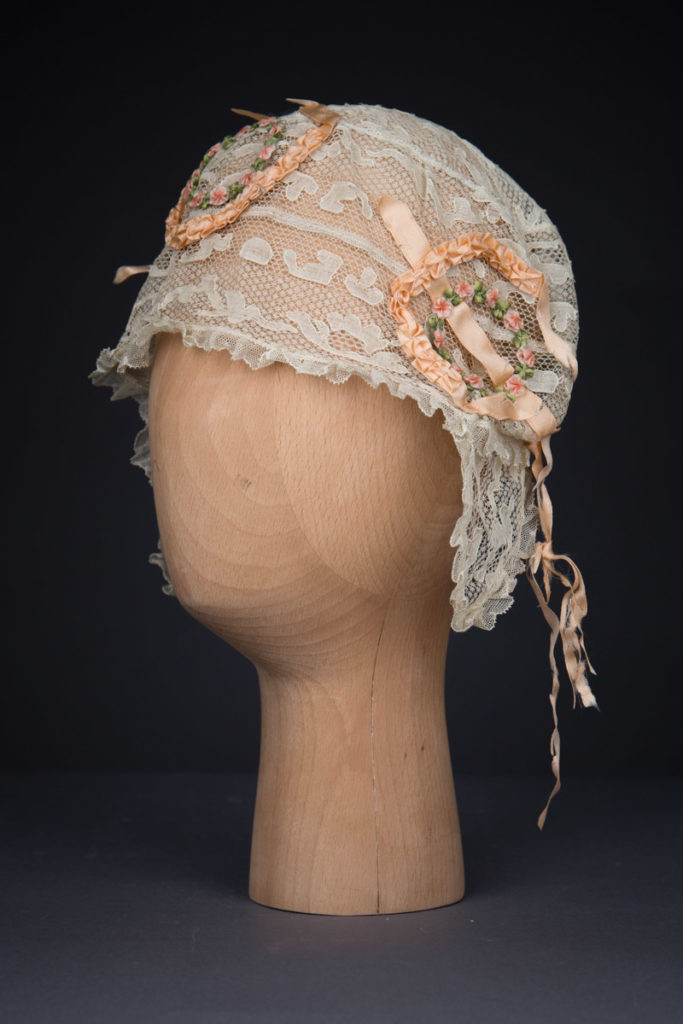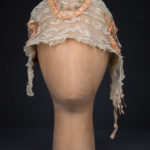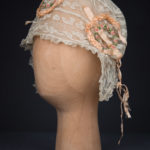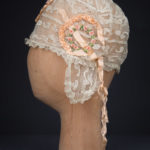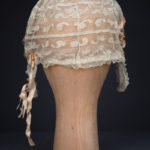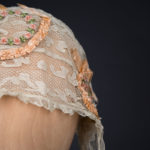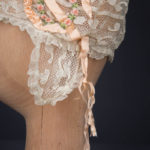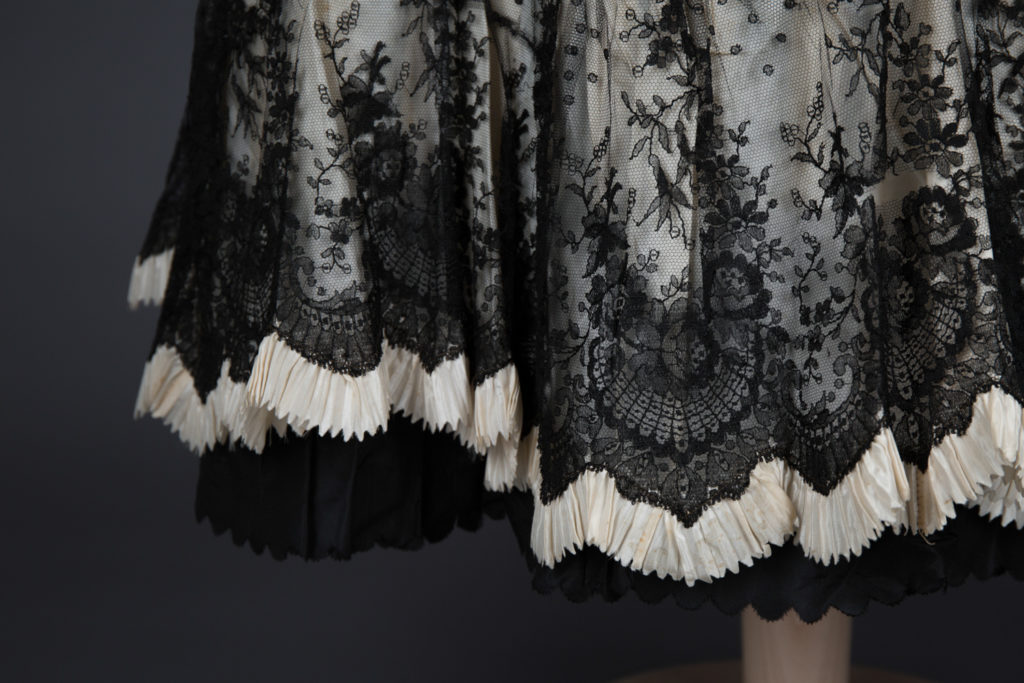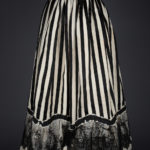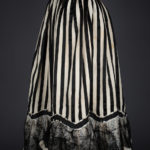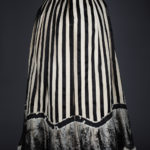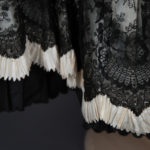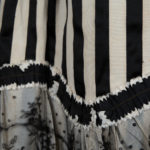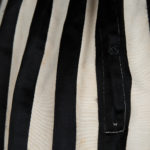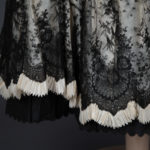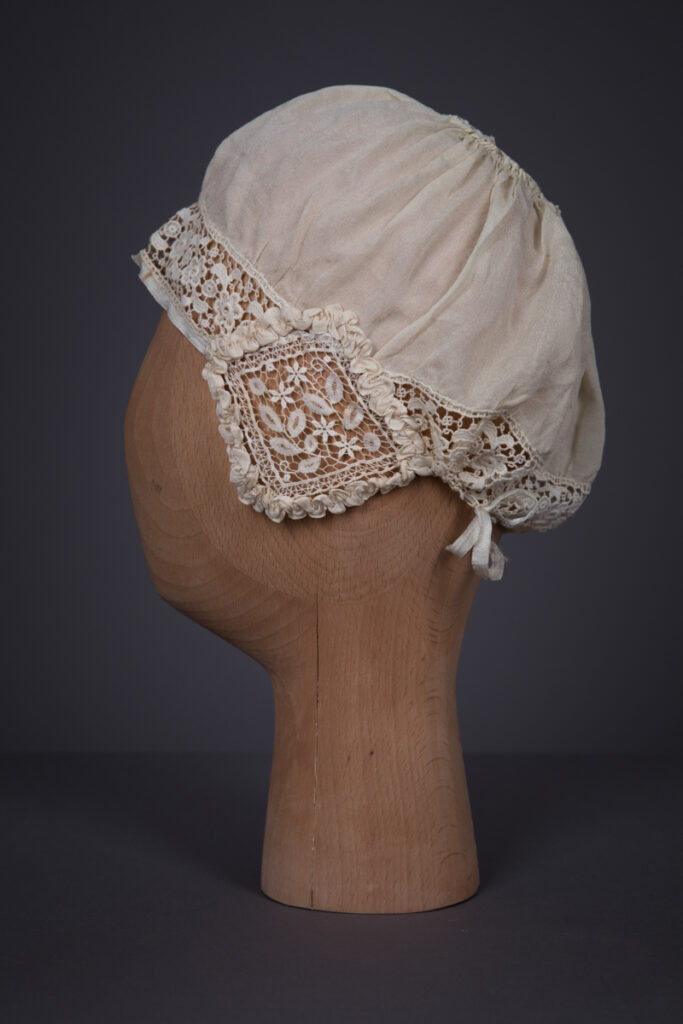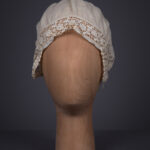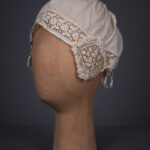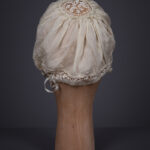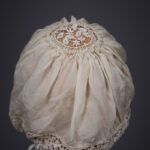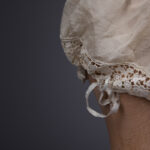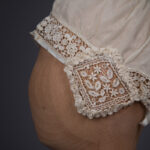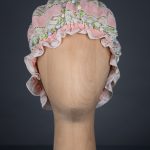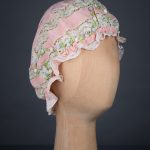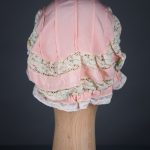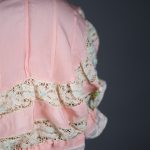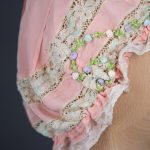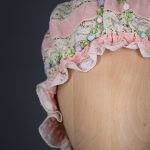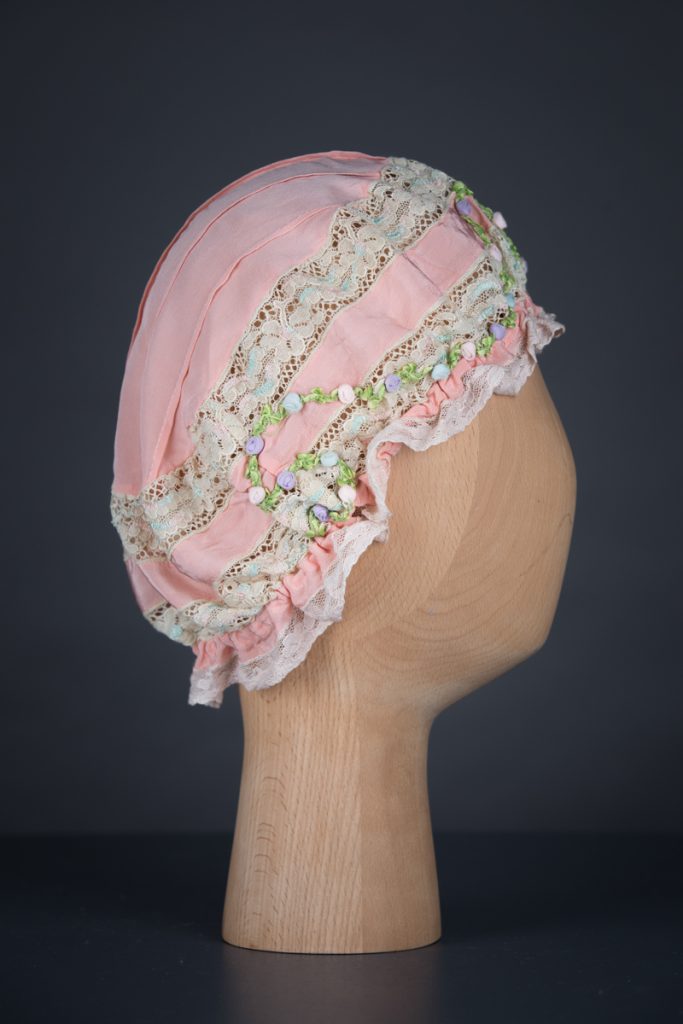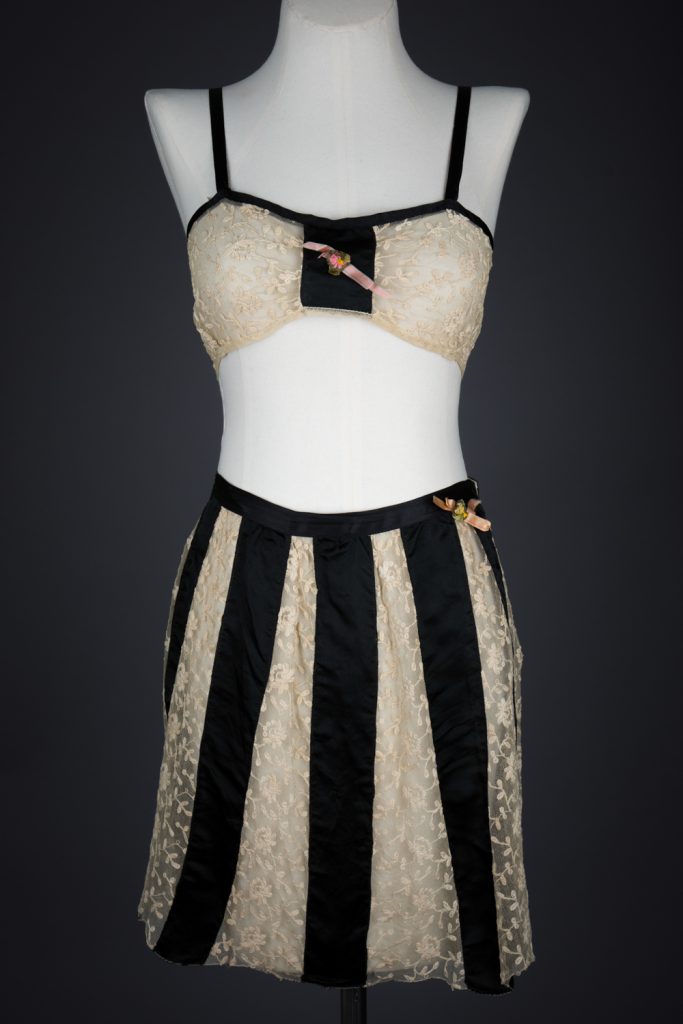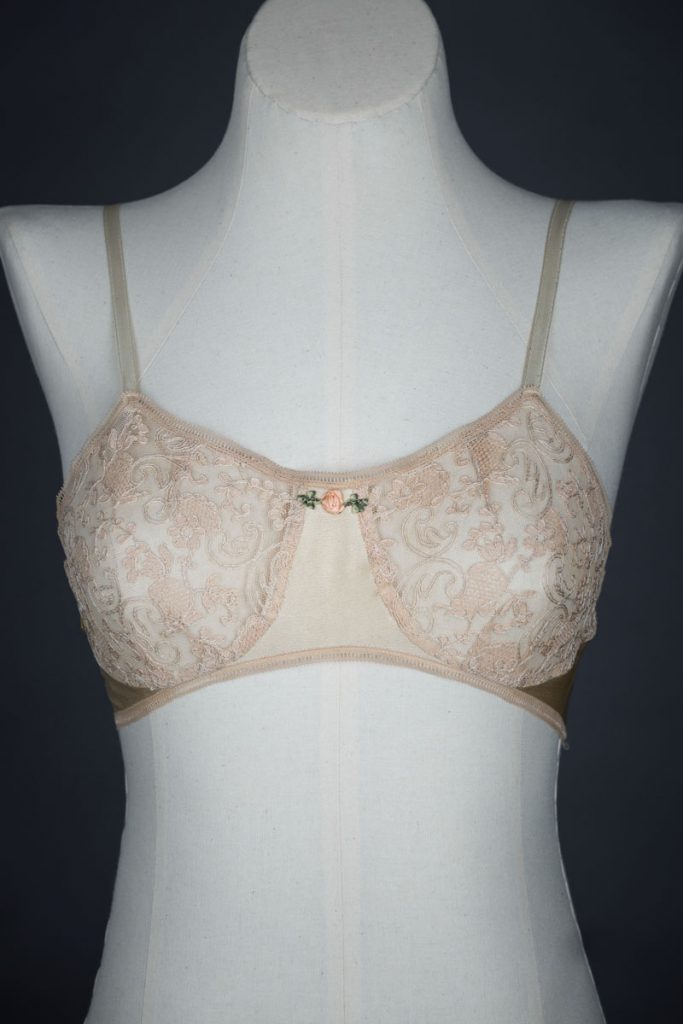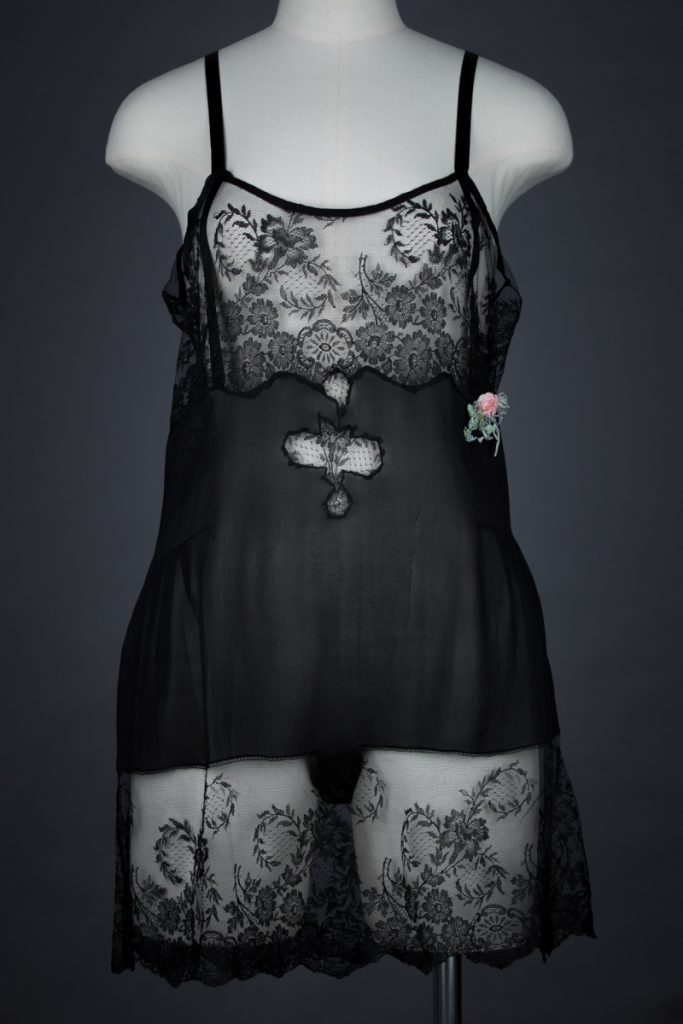Overall, the boudoir cap uses and maintains the visual language of a time and style already past. This allowed the women who wore them to be following the fashion while also maintaining a known and thereby ‘safer’ version of erotic appeal for themselves. While there are great stylistic differences between the surviving boudoir caps, the decorative elements many of them display – white lace ruffles and a light or pastel colour scheme – correspond with the visual language of the Edwardian petticoat. The sexual signifiers used in boudoir cap designs are not those of the interwar years but those of the Edwardians, or one generation into the past.
Chapter Eight: Using Erotic Signifiers Of The Past
Cream Machine Lace Boudoir Cap With Silk Ribbonwork & Wired Ear Covers
Date: c. 1920s
Origin: Great Britain
Fabric: Lace & Silk Ribbon
A boudoir cap in a base of allover ecru leavers lace with narrow trim, embellished with profuse silk ribbonwork in structures of rosettes and ribbon streamers. The ear covers are threaded with millinery wire and can be bent into the wearer’s desired shape.
Striped Underskirt With Lace & Pinked Trim
Date: c. 1890-1900s
Origin: Unknown
Fabric: Silk velvet and cotton
Brand: Custom made
An elaborate underskirt with a silk velvet waistband, printed striped cotton, and an intricately trimmed hem incorporating gathered pinked silks and fine chantilly lace. The lace hem has numerous areas of damage, which has been repaired somewhat clumsily, resulting in an uneven hemline. During the 20th century the skirt was repurposed as a piece of costume rather than underwear, where it presumably sustained this damage and amateur repair work.
This underskirt would have been worn below another skirt or gown, but unlike a petticoat, was designed to be left partially uncovered and visible (hence the elaborately embellished hemline).
The eroticism of Edwardian underwear arises from two main elements: its creation of ‘fictitious curves’ and a visual language of excess and ruffles, both supported and anticipated through the ‘frou-frou’ of different layers of undergarments rubbing against each other when walking. This meant that these new items of lingerie and their ‘frou-frouing mysteries’ were not only designed to be seen but also to be heard. (Cunnington, Cunnington, 201). Both the Edwardian petticoat and the 1920s boudoir cap share the purpose of being seen. Barbier and Boucher argue that the petticoat had long been the exception in undergarment design since “often decorated and colourful, as they were meant to be seen.” (Barbier, Boucher, 188). Just like a petticoat would be visible when walking up the stairs for example, the boudoir cap was strategically put on in situations where one had an audience. Mannin for example described that “In hotels you did not admit the waiter or chambermaid to your room until you had pulled on a pretty boudoir cap. In your own home you put it on even if it was only your husband bringing the tea, or your twenty-five-bob-a-week ‘cook general’, always referred to as ‘the maid’.” (Mannin, 70). Steele also points out how wearing lingerie was a pleasurable sensation to the wearer. In D’Orchamps, Tous les secrets de la femme, this joy becomes obvious: “This paradise of fine and soft lingerie …this warm and luxurious temple that shakes at our least shiver; this little fortune that the elegant woman hides under her dress” serves “to tranquilize” her.” (quoted in Steele (1985), 207). The delight and pleasure Edwardian women experienced in their petticoats – ‘‘As I knew my frillies were all right, I hammocked too, and it was lovely.’ (Glyn, 16) continued into the 1920s through the fun of wearing a boudoir cap. Wearing one women had the safety of using visual language they were already familiar with and relying on sexual signifiers that were already established.
Silk Habotai & Chemical Lace Boudoir Cap With Ribbonwork
Date: c. 1910s
Origin: Unknown
Fabric: Silk, lace
A boudoir cap in silk habotai, trimmed with chemical lace. Machine lace panels cover the ears, framed by silk ribbonwork ruffles. A third panel of chemical lace is inserted into the crown of the cap, with the silk habotai gathered around this circular panel. Silk ribbon is slotted through the lace trim at the centre back of the cap, and can be gathered and tied to tighten the cap.
Silk Crêpe & Insertion Lace Boudoir Cap With Silk Ribbonwork & Pin Tucks
Date: c.1930s
Origin: Great Britain
Fabric: Silk crêpe, insertion lace and silk ribbon
Brand: Custom made
A boudoir cap with a pink silk crêpe base with rows of ecru and blue insertion leavers lace, embellished with silk rosette ribbon. The crown of the cap has delicate machine pin tucks. The edge of the cap is trimmed with a narrow white lace trim. The cap was originally elasticated with a narrow cord elastic, though this has now perished and offers no stretch or recovery.
Black Silk & Embroidered Tulle Bra & Tap Pants by Owl Make
Date: c. 1920s
Origin: United States
Fabric: Silk and tulle
Brand: Owl Make
A bandeau-style bra and tap pant set, most likely from the mid to early 1920s. The bra’s simple shape was designed to flatten the bust into the fashionable ‘boyish’ silhouette. The tap pants are an early version of the style, constructed as a half slip with a single piece of ribbon stitched between the legs. This style of tap pant represented one of the first commonly worn style of underwear that incorporated a closed gusset for women, as previously only ‘open’ drawers had been viewed as acceptable.
Silk & Lace Bra By Warner's Egyptian
Date: c. 1920s
Origin: United States
Fabric: Silk and lace
Brand: Warner’s ‘Egyptian’
Unusually for the 1920s, this bra features shaped, separated cups. In line with the fashionable silhouette of the period, these cups are cut with relatively little volume, and so would offer rather a flattening effect to the bust, rather than the lifted and separated shape that became popular in the 1930s.
The bra has a number of luxurious details: the cradle is made from silk charmeuse lined with cotton tulle, and the cups from a Schiffli embroidered cotton tulle. The neck and underbust edges are finished with a narrow lace trim. The shoulder straps are made of silk ribbon, and a silk ribbon rosette embellishes the centre gore. The bra fastens with a pre-made, cotton twill hook and eye tape. The garment is entirely machine stitched, using mostly a very fine and narrow zigzag stitch.
Black Silk & Lace Ribbonwork Step In
Date: c. 1920s
Origin: United States
Fabric: Silk
Brand: Custom made
This silk georgette step in has a simple cut, typical for early 1920s lingerie. The chemise shape is based on rectangles with gathers at the waist for shaping and a simple strip of ribbon forming a gusset between the legs. This ribbon style was one of the earliest forms of gusset in women’s underwear. The leg and bust are trimmed with silk leavers lace, with the neckline bound in silk ribbon and silk ribbon straps. The centre front has an appliquéd lace motif, with a silk ribbonwork motif at the left of the underbust.
Navigation
Chapter One: Introduction & The Boudoir Cap’s Predecessors
Chapter Two: A Rite Of Passage Into Adulthood
Chapter Three: Glamour For All
Chapter Four: An Affordable And Attainable Way Of Achieving The Boudoir
Chapter Five: A Safe Version Of Sex Appeal
Chapter Seven: Dress For Undressing
